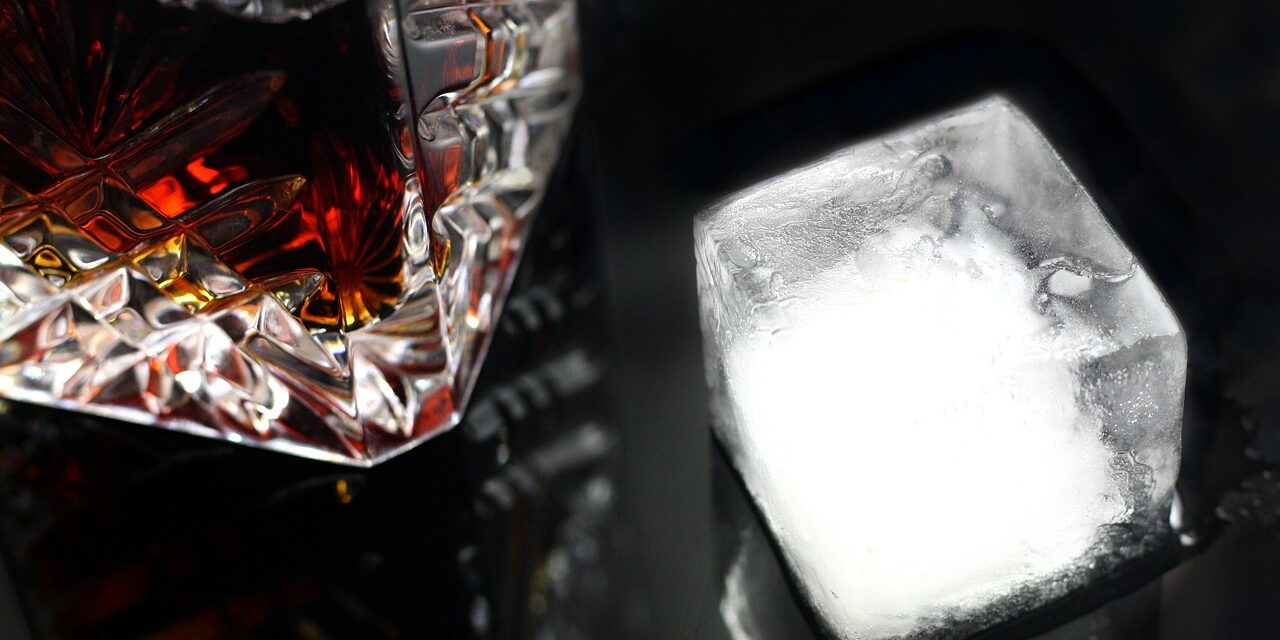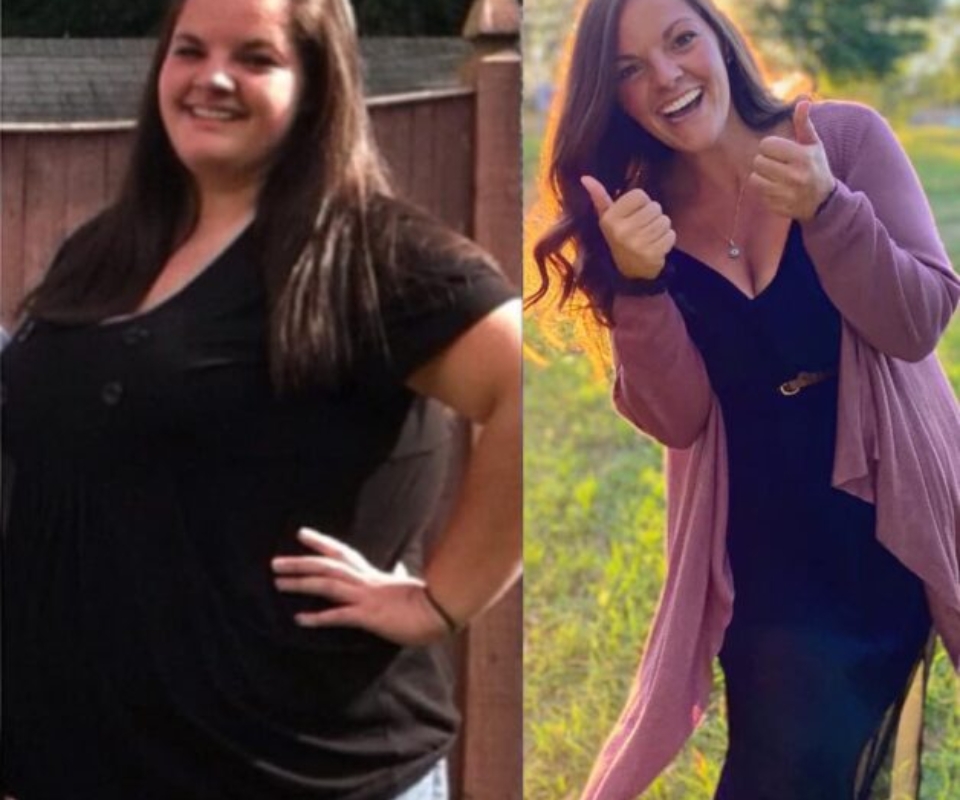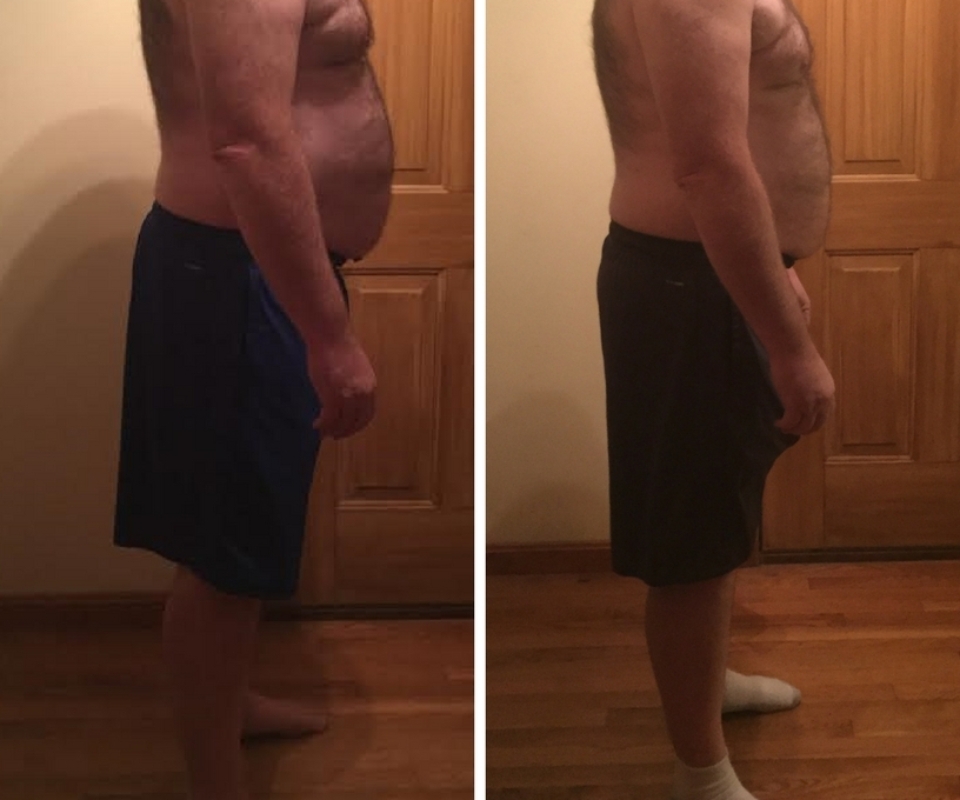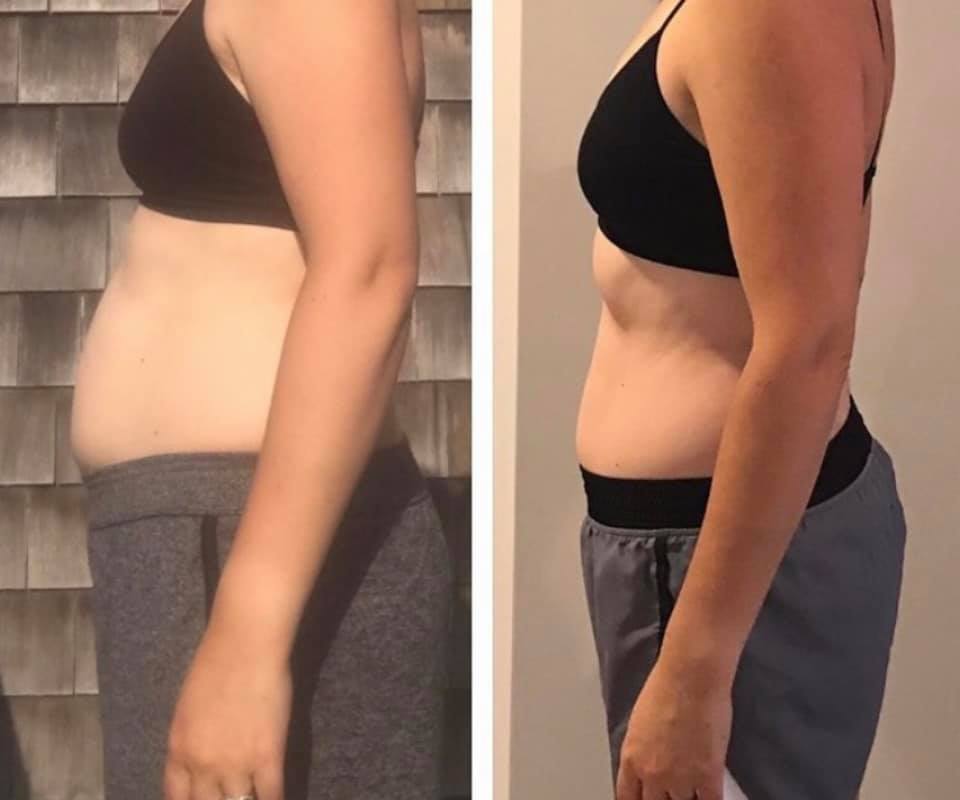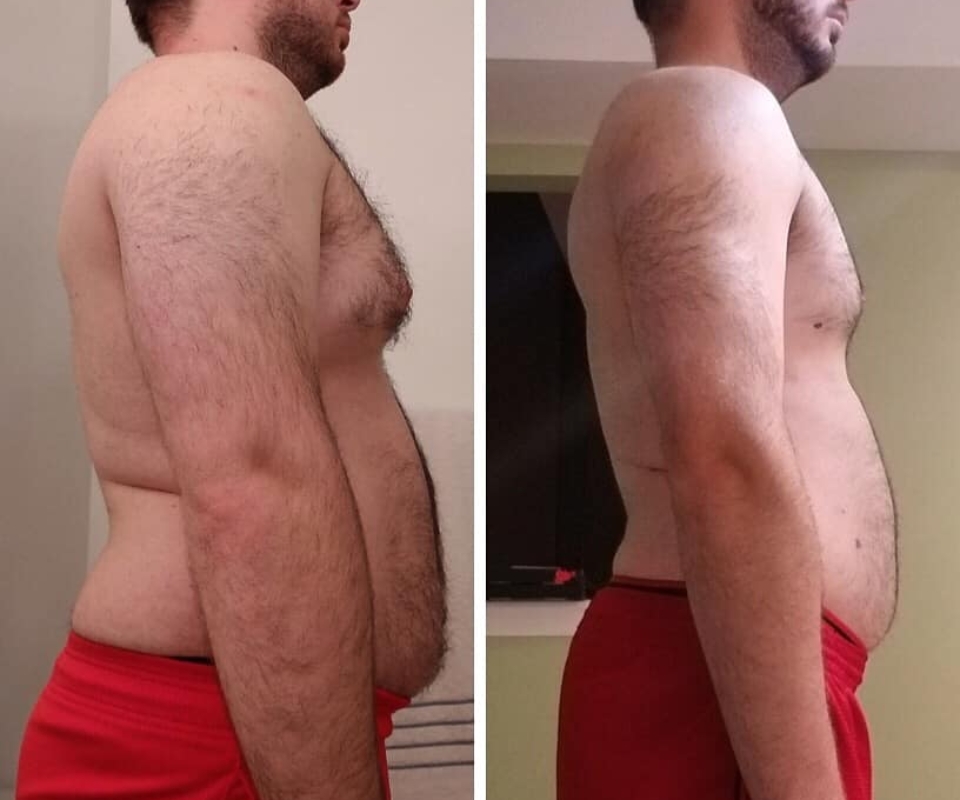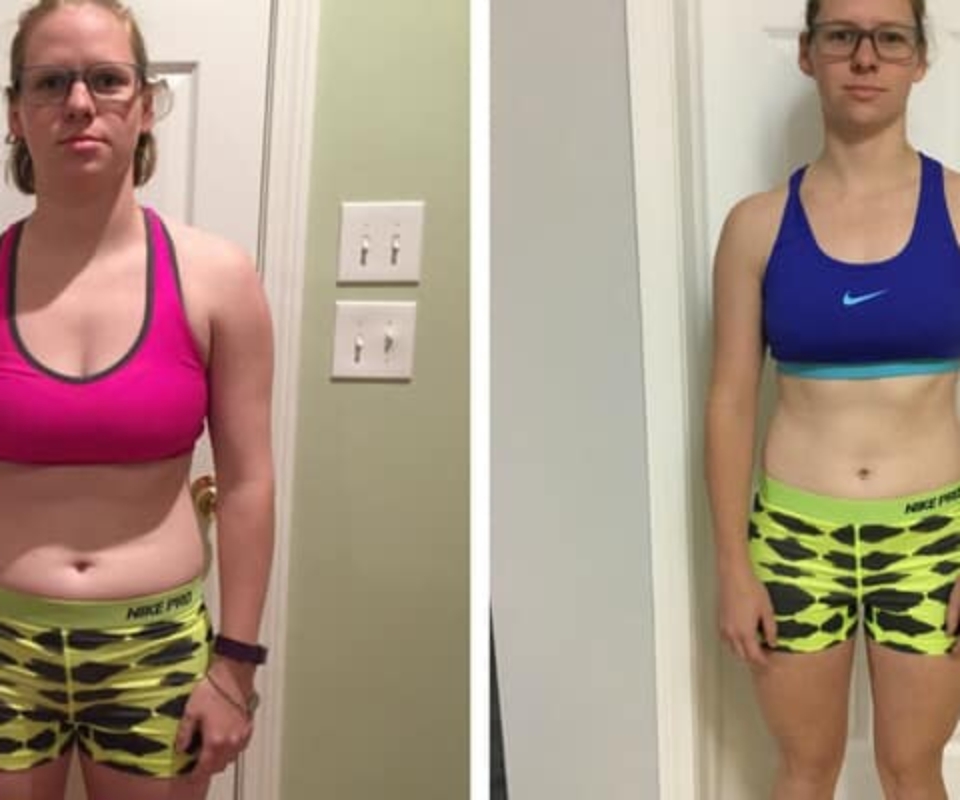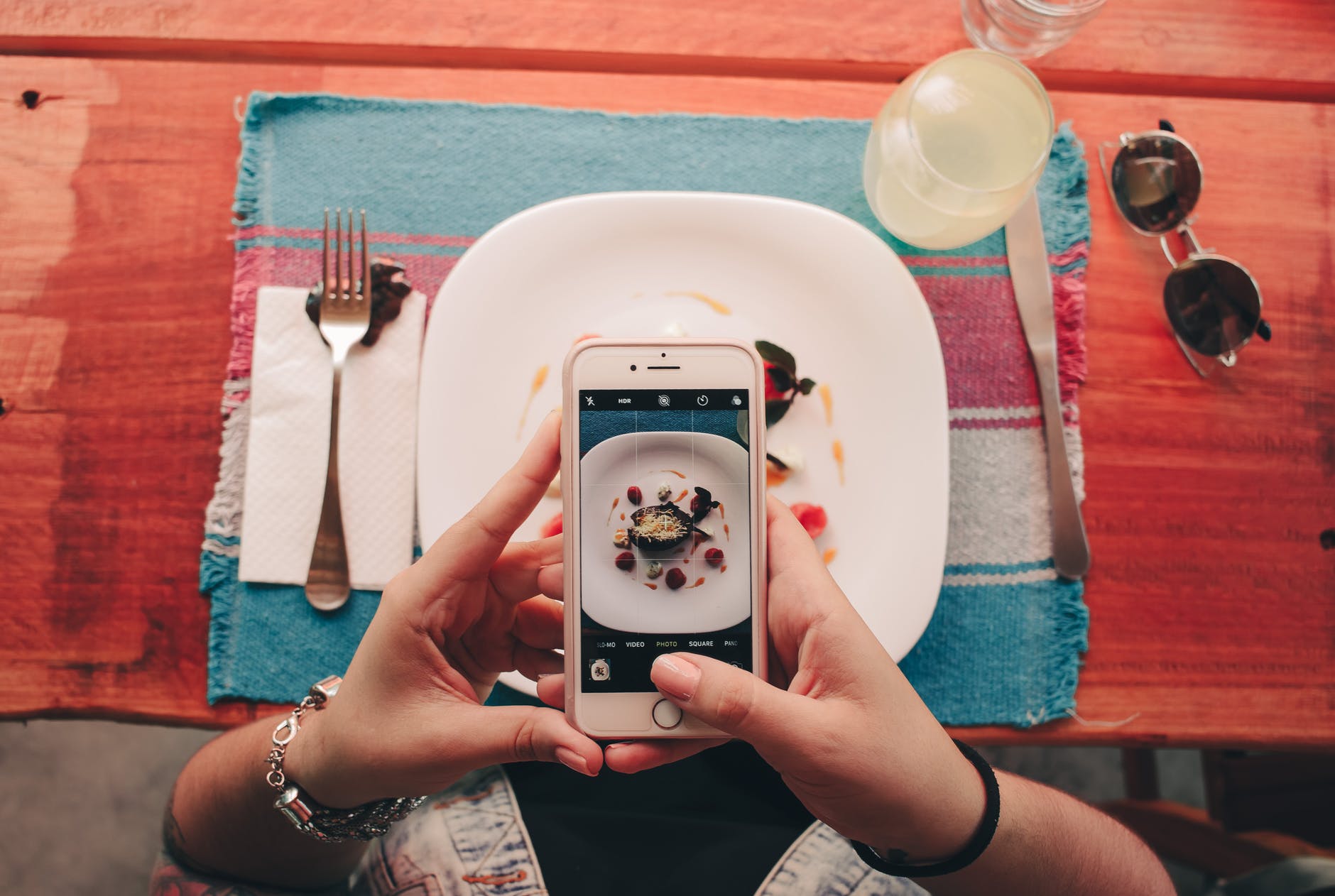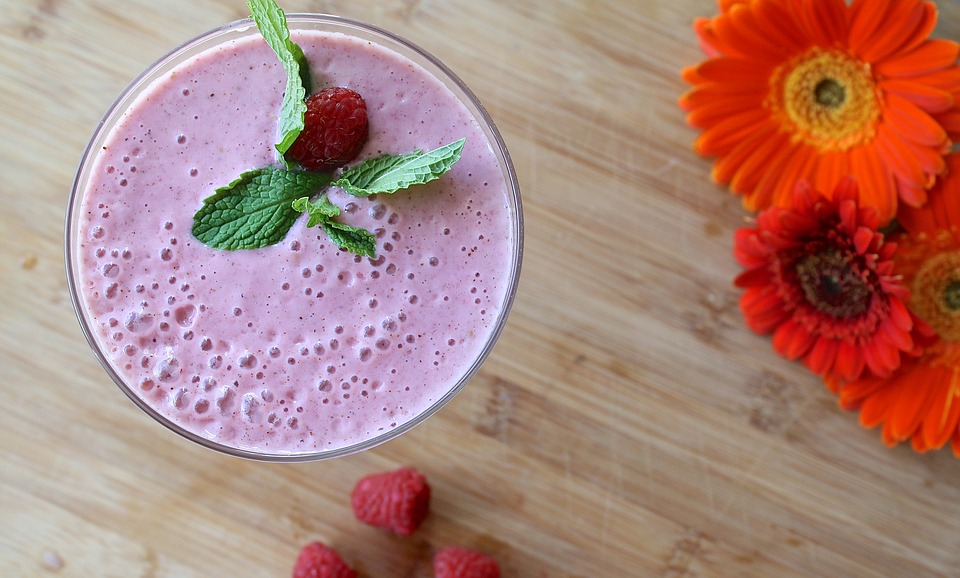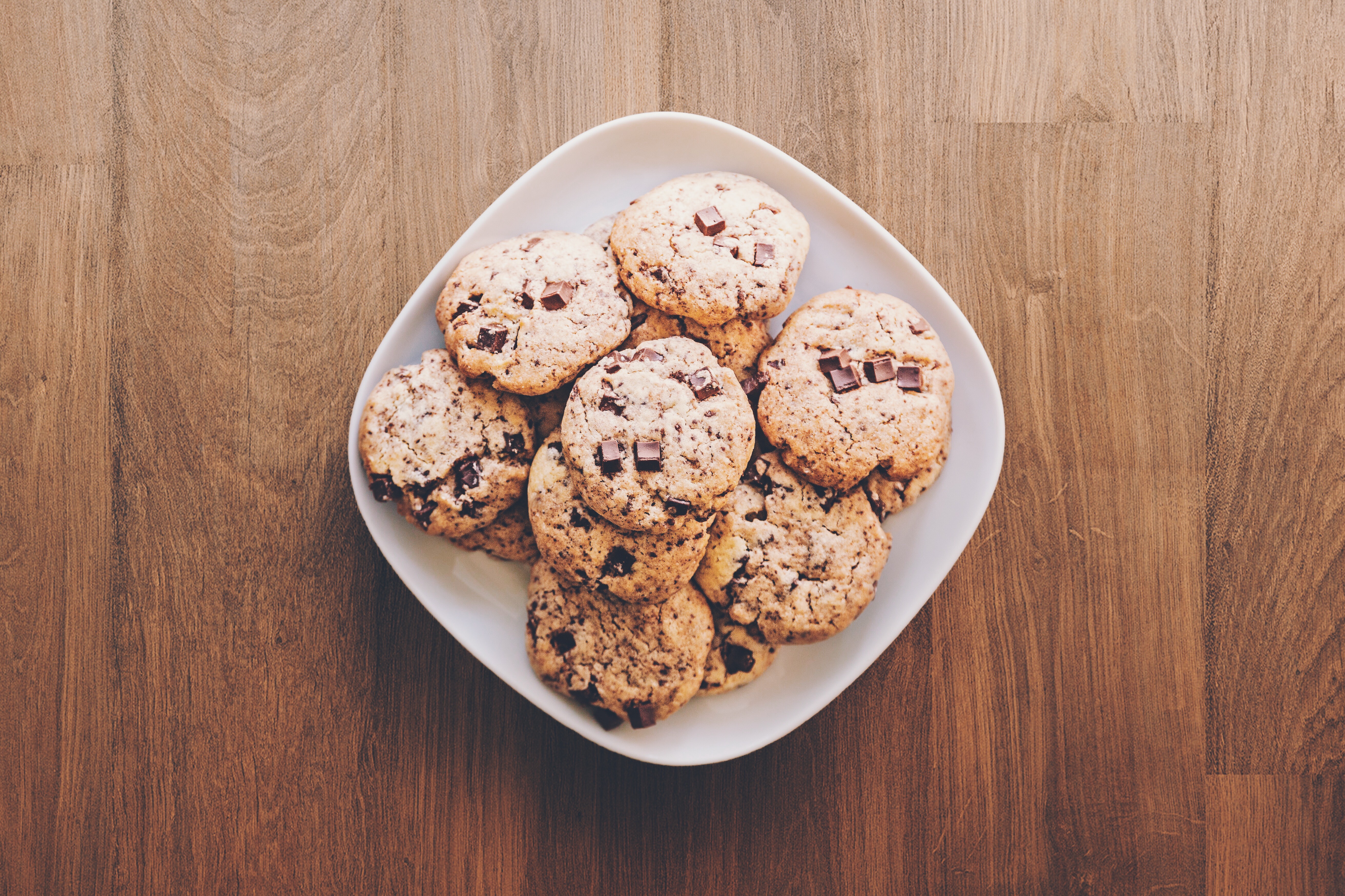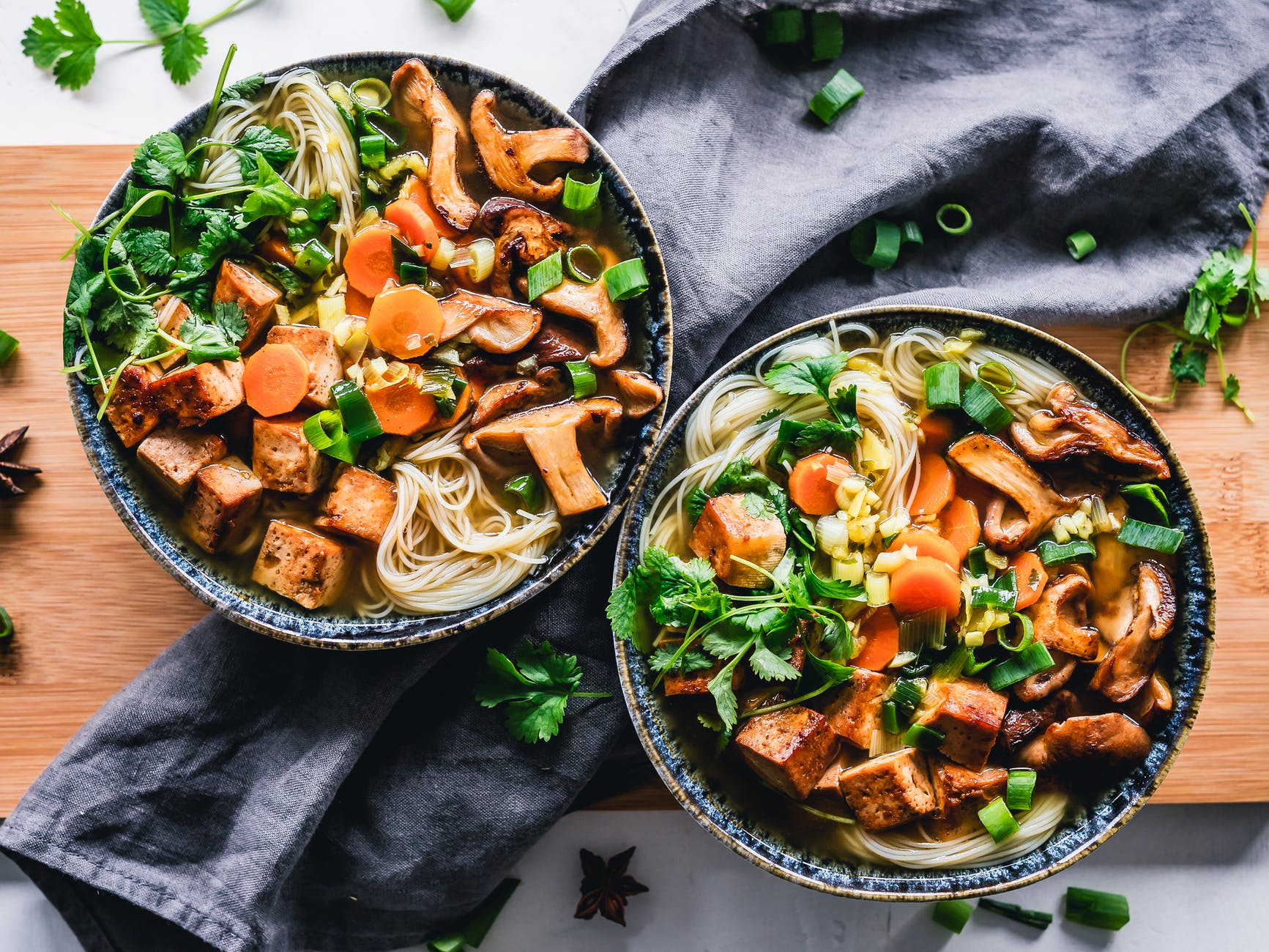Almost everybody I speak to on coaching consultations wants to know if they’ll be “allowed” to drink when working with me.
The answer is always a resounding yes.
I don’t ask anybody to do anything in the short-term that doesn’t at least resemble an approach they can follow in the long-term. But I also make everybody aware of the inevitable downsides of drinking while dieting:
✕ Lower quality sleep
People typically counter this by assuring me they pass right out after drinking—but your ability to fall asleep is very different than your ability to get quality sleep. And low quality sleep contributes to:
– Hindered weight loss
– Increased muscle loss
– Next-day cravings and hunger
– A harder time staying full
The actual list of low quality sleep-driven issues is much longer than this, but these are the primary downsides for someone with transformation-specific goals.
✕ Increased cravings and hunger
When was the last time you got buzzed and decided on a rice cake and salad for dinner?
Thought so.
Drinking is a one-way ticket to intense cravings AND the inability to overcome them (because alcohol lowers inhibition).
At which point, its negative effects on sleep will leave you hungry as hell the next day, because ghrelin (your hunger hormone) will spike. To make matters even worse, leptin (our fullness hormone) is also negatively affected—making it harder to get full.
So you’ll experience weakened willpower in the moment, intensified hunger the next day, and a harder time getting full: a dieter’s dream!
✕ Increased likelihood of overeating
Again, this comes down to alcohol’s negative effects on decision-making abilities. I’ll be the first to admit that I start dreaming about baked goods and pizza when I’m 3-4 drinks in—at which point, I’m fairly likely to say “Screw it; I’ll start fresh tomorrow.”
✕ Increased likelihood of of missed workouts
I actually have a VIP Nutrition Coaching client who schedules his group exercise classes for 7AM or 8AM on the weekends, as this forces him to make smarter decisions the night before. If he didn’t do this, he’d (self-admittedly) blow off his workouts after he drank. And while the occasional missed workout isn’t the end of the world, making a habit of it isn’t wise.
You could say this strategy has worked quite well for him:
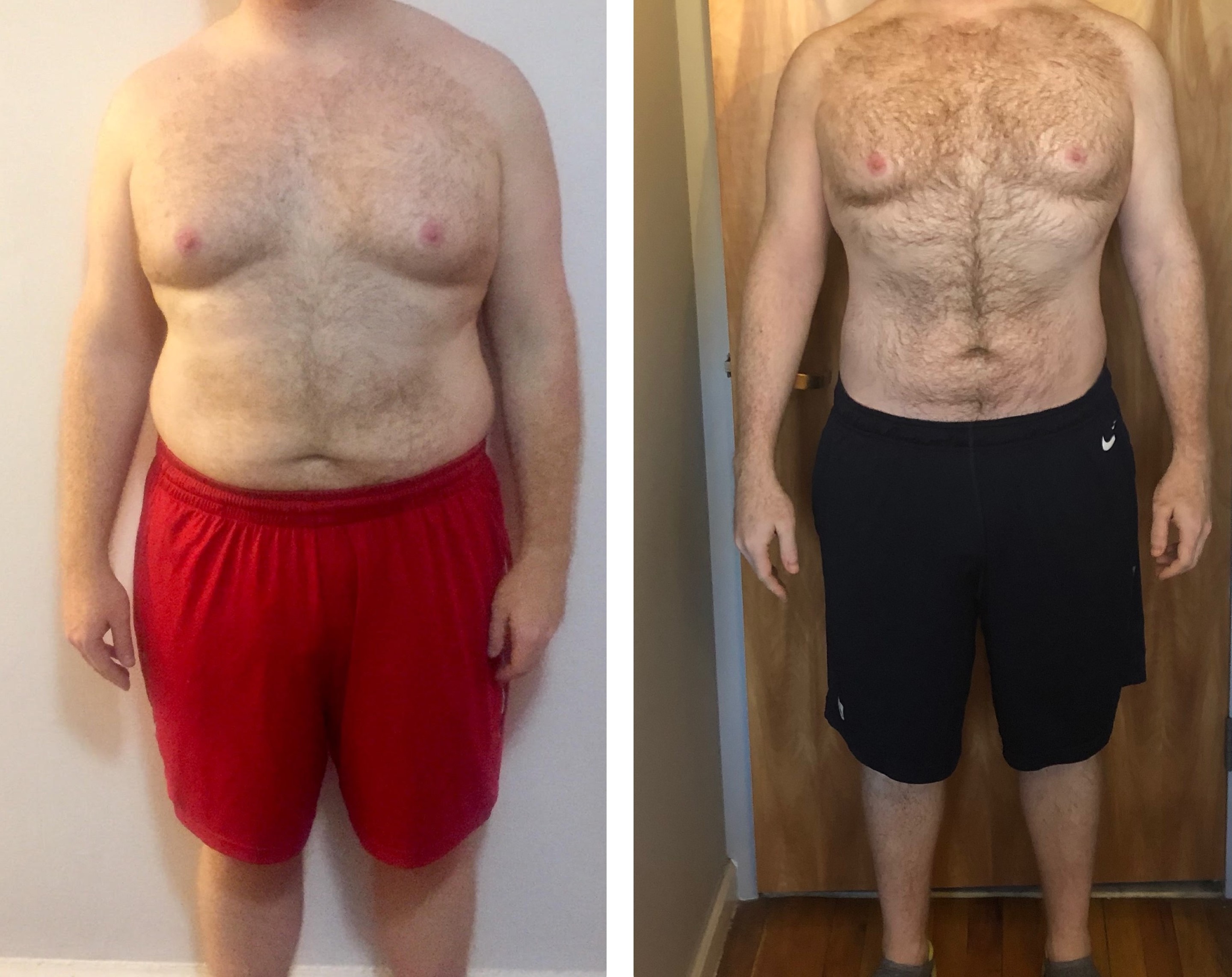
✕ Hindered fat burning ability
To top it all off, our body struggles to metabolize food after drinking—meaning you won’t burn calories as efficiently until the alcohol is metabolized. In itself, this isn’t a big deal, but it becomes increasingly impactful the more you drink.
Now, you might look at this list and think it doesn’t apply to you because you don’t drink often, or don’t drink heavily when you do—but trust me when I tell you this does NOT exempt you from experiencing alcohol-related issues.
You still will, even if it’s to a lesser degree, and you need to be 100% comfortable with that if you’re choosing to drink while dieting.
If you are, and you’d still like to drink, here’s the best way to approach it:
1) Choose your splurges more wisely
Very few nutrition coaches will “admit” you can’t have it all (it scares people off). But I don’t mind being the exception and being honest with you: you can’t get away with an appetizer and an entrée and dessert if you’re also drinking.
Successful dieters have to get really picky about what they value the most in a meal.
A good example of this is a taco night—whether it’s at a restaurant or at home. Most people have chips and guac (the app), the tacos themselves (the entrée), and 2+ margaritas—nevermind a dessert.
But this will blow your calories out of the water (even impacting previous days’ progress) if you’re not careful. So I like to think of situations like this as having ten “tokens” I can spread evenly across:
The chips and guac (five tokens)
Three tacos (five tokens)
Two margaritas (five tokens)
Dessert (five tokens)
My best bet here would be picking the two items I value the most and “spending” my tokens (calories) there. But I can also spread them across more items if I reduce portions accordingly. To paint a better picture, let’s pretend I wanted to drink more than I wanted to splurge on food. I could divide my tokens like this:
A few chips (no guac): two tokens
Two tacos: three tokens
Two margaritas: five tokens
No dessert: zero tokens
Chips, tacos, and margaritas is still a highly enjoyable splurge meal, and very much in line with most dieter’s goals. That’s why I’m such a huge fan of the Token Method.
2) Know your number
If I have two drinks, I have no issues sticking to my diet and being productive the next day. If I have three, I can be easily persuaded (by the devil on my shoulder OR my friends and family) into poor food choices and a late night.
If I have four, forget it. I’m almost definitely throwing in the towel, no longer tracking my food, and making bad choices.
(Any other lightweights here?)
Each one of us has a specific amount of drinks* that almost always derails us, and we need to be familiar with what this “screw it number” is. That way, we can plan well and reduce the likelihood of major setbacks.
*If you realize that this number is lower than you’d like (or are used to), it’s worth questioning how many drinks genuinely add to your social or dining experience. At a certain point, another drink has very little impact on the memories you’re trying to make.
3) Know the “best” low calorie drinks
Dr. Nancy Priston of EveryStepFitness.com put together an excellent graphic on these:
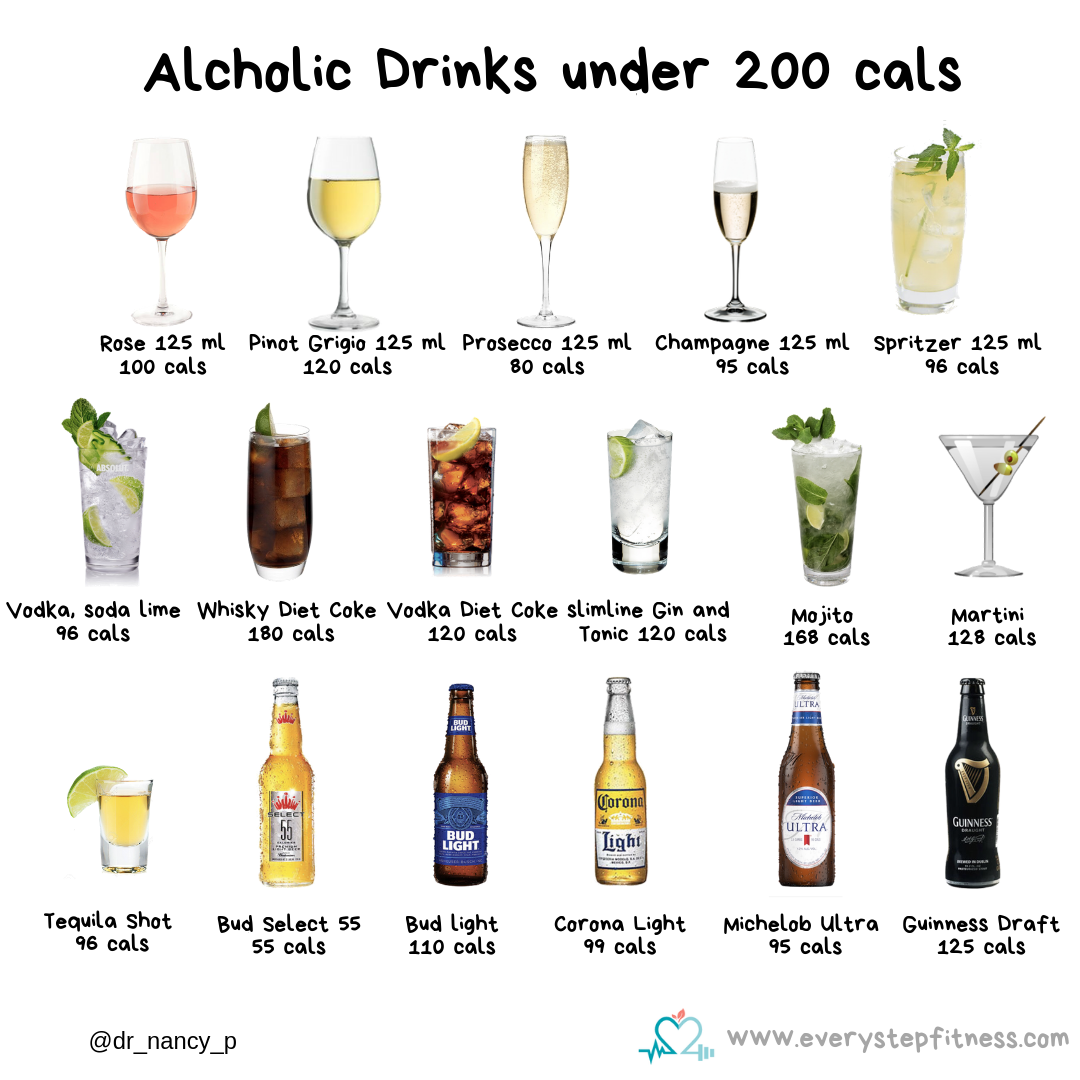
You might not see your favorite drink here, and that’s okay. That doesn’t mean you can’t work it into your plan. But it’s worth questioning how much food you’ll have to sacrifice (to hit your calorie target) when including a high calorie margarita or cocktail.
Again: successful dieters are selective splurgers and often pick their 2nd or 3rd favorite option for the sake of continued progress.
4) Reduce carbs and fats when planning your meals
Most people are familiar with the main macronutrients and their calorie totals:
Protein: four calories per gram
Carbs: four calories per gram
Fats: nine calories per gram
But most people don’t realize that alcohol is also a macronutrient with seven calories per gram. This is because it’s never listed on labels and offers almost no nutritional value (thus the “empty calories” term you may have heard before).
With this (perhaps new) information in mind, you can go ahead and reduce carbs and fat calories to “make room” for alcohol calories. For example, your typical day of eating might be:
Meal 1: Eggs and an apple
Snack: Trail mix
Meal 2: Salad with chicken and almonds
Meal 3: Ground beef bowl with rice and guac
But you decide you want to work alcohol into your plan. You can now make these changes to make the numbers work:
Meal 1: Egg whites (less fat) and an apple
Snack: Grapes and baby carrots (less fat)
Meal 2: Salad with chicken and almonds
Meal 3: Ground beef bowl with a half serving of rice and guac (less carbs and fat)
These subtle adjustments would free up hundreds of calories for a few drinks with any meal.
5) Plan on slip-ups and mediocre decisions
Not included in the above plan is the inevitable slip-up or mediocre decision.
It’s a scenario where “You don’t slip up every time you drink, but every time you slip up the most, you were probably drinking.”
Knowing this, it’s wise to plan accordingly and:
✓ Save another few hundred calories for a drunk snack or two. The only downside to this is the potential proactive fantasizing over what you’ll use your extra calories on—rather than practicing mindfulness and deciding if you genuinely want to splurge more in that moment.
✓ Make sure splurges aren’t readily available all around you. After all, environment is everything, and if you’re feeling buzzed while walking by a pantry or half-eaten appetizer, your willpower will not-so-mysteriously go missing.
✓ Use the Weekend Warrior approach to calorie counting, which is perfect for dieters who enjoy being social on the weekends, and want to plan accordingly. In short, it’s a combination of five low calorie days and two high ones (averaging to your usual target).
✓ Not panic if you blow every one of these strategies. Again, slip-ups are inevitable, and your ability to get the you-know-what over it and quickly bounce back afterwards heavily determines dieting success:
(The above video mentions overeating. But the very same bounce-back strategies apply to drinking.)
6) Don’t miss twice
If you want to enjoy a few drinks on a Saturday night, go right ahead. Just don’t end up at a diner breakfast the next day* with any expectations of meaningful progress for the week. Even two days of poor choices can offset a week’s worth of good ones (as evidenced in this graph):
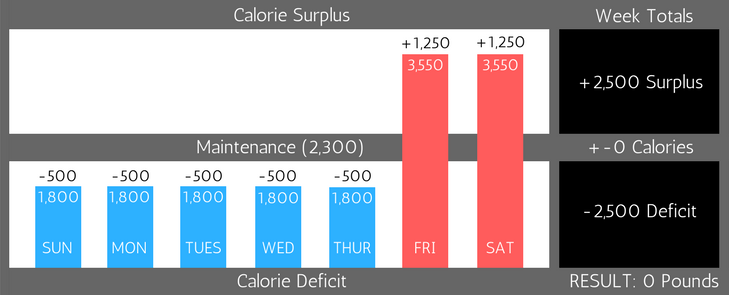
With this in mind, I’m challenging you to “not miss twice”—which means a Saturday night or drinking should be followed by a fairly healthy Sunday morning breakfast. Trust me when I say you’ll feel dramatically better (physically AND mentally) if you don’t let yourself spiral.
*Your favorite “hangover foods” don’t actually sober you up. That’s a myth.
7) Question your “non-negotiables”
Some of the clients that I’ve worked with that have hardest time making progress are the ones that refuse to question their “non-negotiables.” Because everybody needs to be comfortable with scenarios where:
✓ Your partner is drinking at dinner and you’re not. If this sounds absurd to you, you’ll have a hard time making progress.
✓ You don’t get another round when the rest of your friends are. Again, this can’t be a big deal. If you do what everybody else does, you’ll get the same results—and I KNOW you’re tired of that. So get over your FOMO and learn how to say “no.”
✓ You STOP thinking you need a “cold one” or glass of wine to unwind. Not only is this a problem for the reasons listed above, but you’re also feeding into a cycle where (A) you don’t learn to manage stress properly, and (B) you become too high maintenance of a dieter to actually make progress.
✓ You STOP associating the weekends with drinking (for at least a few months). If I can tell the difference between a client’s weekday food log and weekend food log without looking at the dates by alcohol intake alone, progress isn’t likely.
BONUS #1: Consider alternate activities
Courtesy of social conditioning, we hit our 20’s and think every social activity needs to involve alcohol—whether it’s brunch, a beach day, night around a fire, or even a game night—to have fun. And while I’m not denying the spark drinking can add to moments like this, asking a friend to go on a walk or watch a completely movie sober can’t be out of the question.
(You’d be surprised how many other people want to do something that isn’t “catching up over drinks.” You just need the be the one to suggest it.)

BONUS #2: Own your decisions
I can’t tell you how many clients I’ve had tell me “the [INSERT SPLURGE HERE] got the best of me” after they began drinking. The problem is, the insinuates a lack of control that DOES exist.
Nobody’s making you drink more than you should. Nobody’s making you order takeout or stop at Taco Bell on the way home.
This isn’t to say these things are inherently bad, or that they need to be avoided altogether—but you’re an adult who’s 100% responsible for your decision-making… whether drinking or not. So own up to your decisions and take your power back.
Let’s recap the main things to consider when drinking during a diet:
✓ Certain downsides are inevitable: like poor sleep, increased cravings and hunger, a harder time sticking to your plan, and the hindered ability to burn calories. These affect everybody, no matter how little you drink. Naturally, they get worse the more (frequently OR heavily) you drink—often to the point of preventing progress altogether.
✓ There are things you can do to “minimize the damage,” like cutting back on food splurges (with the Token Method), planning to have a low number of low calorie drinks, and getting more comfortable saying “no” and being the only one not drinking.
Another strategy many of my VIP Nutrition Coaching clients use to practice moderation is a Weekly Drinking Quota, which I explain in this one minute video:
Although it’s worth noting that I’ve since modified the recommendations I gave in this video (after seeing too many people push the limit), and typically recommend no more than 5-7 drinks per week for women, and 8-10 drinks per week for men.
Any more than this intensifies the symptoms of drinking in a major way, and makes the transformation process much harder than it needs to be.
Speaking of which: I’d love to help YOU lose fat as painlessly as possible.
That means no crazy strict plans or banned food and drink lists.
I also check in with my VIP Nutrition Coaching clients several days per week, ensuring their days are well-planned AND that they’re sticking to their plans.
Imagine how much better your decision-making would be me with me over your virtual shoulder?
This level of personal accountability produces results like this:
I liken it to driving next to a state trooper on the highway: you’re going to be on your best behavior with them nearby.
You can learn more about how I do things and apply for a spot here:

